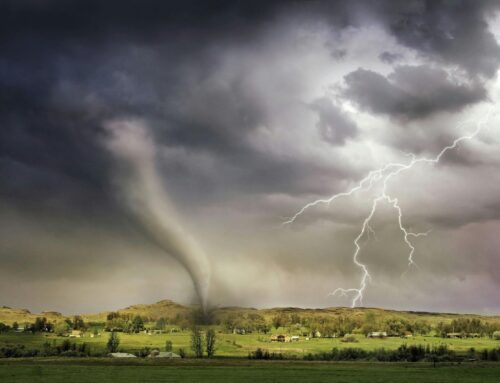The term anemometer is derived from a Greek word, anemos, meaning wind. The earliest description of an anemometer was in 1450 by an Italian architect, artist, and author Leon Battista Alberti. An anemometer is an instrument that measures wind speed and wind pressure. Anemometers report wind speed in miles per hour (mph), kilometers per hour (kph), meters per second (m/s), or knots.
Who Uses Anemometers?
Meteorologists
Anemometers are important tools for meteorologists, who analyze weather patterns, wind speed, and direction. With the data, meteorologists can calculate wind pressure. Wind pressure is the force exerted on a structure by the wind. Measuring wind speed is important for defining weather hazards, especially for tornado warnings and high-velocity wind exposures.
Aerospace Engineers and Physicists
Anemometers are important tools for aerospace engineers to determine design concepts to make them more aerodynamic and physicists are currently studying the theory of One-dimensional Ultrasonic Anemometers, the influence of wind speed and temperature to sound propagation.
Marine Operations
Anemometers are important tools for marine operations because wind speed determines wave height. Larger waves can cause navigation problems for mariners.
 Skydiving
Skydiving
Anemometers are important for skydiving because wind speed needs to be calculated to ensure that a skydiver is safe during their jump. Sudden wind changes can make it harder to land the parachute.
Drone Pilots and Aircraft
Anemometers are important for drone pilots because a sudden gust of wind can disorient a drone and cause it to crash. Some drones cost more than $10,000 and are equipped with LiDAR (light detection and ranging) and methane detection, used for 3D models and detecting dangerous gas leaks.
Aircraft landing systems use anemometers to gauge the correct landing speed and procedure. Anemometers can also help in choosing the ideal take-off runway, establishing the fastest flight route, and avoiding possible turbulence.
Agriculture
Anemometers are important for the agricultural industry because crop spraying relies heavily on wind patterns and use an anemometer to run daily operations. Determining the right wind speed is critical because chemicals may not adhere properly to a certain crop, and even worse, damage and kill crops nearby.
 Types of Anemometers and How They Work
Types of Anemometers and How They Work
Cup Anemometer
The most common type of anemometer has three or four cups attached to horizontal arms. The arms are attached to a vertical rod. As the wind blows, the cups turn, making the rod spin. The stronger the wind blows, the faster the rod spins.
The anemometer counts the number of rotations, or turns, which is used to determine wind speed. Because wind speeds are not consistent wind speed is usually averaged over a brief period.
 Windmill Anemometers
Windmill Anemometers
Windmill anemometers are used to calculate the velocity of the wind. The axis will rotate, running parallel to the direction of the wind. It will also consist of an aerovane, which is a propeller and a tail to determine precise wind speed and direction measurements.
Hot-wire Anemometer
Hot-wire anemometer takes advantage of the fact that air cools a heated object when it flows over it. In a hot-wire anemometer, an electrically heated, thin wire is placed in the wind. The amount of power needed to keep the wire hot is used to calculate the wind speed. The higher the wind speed, the more power is required to keep the wire at a constant temperature.
Tube Anemometer
A tube anemometer uses air pressure to determine the wind pressure, or speed. A tube anemometer measures the air pressure inside a glass tube that is closed at one end. By comparing the air pressure inside the tube to the air pressure outside the tube, wind speed can be calculated.
Pressure-tube Anemometer
A windsock is also considered a pressure-tube anemometer and they are usually found at airports. The wider end of the sock captures wind as it blows into it. Since the larger end can shift towards the wind, this type of anemometer can give wind direction. Depending how strong the wind blows, the higher it raises to the surface.
 Pressure-plate Anemometer
Pressure-plate Anemometer
Plate anemometers help measure wind pressure. In the plate anemometer, a flat plate is compressed onto a spring, which measures the amount of force the wind exerts. Plate anemometers are mostly used in areas of high altitudes. These anemometers are important during weather forecasting because they indicate times and areas of dangerously high pressure. For instance, plate anemometers are placed on bridges to raise alarms during high windstorms
Conclusion
Anemometers are used in just about every weather station, from the frosty Arctic to extremely hot equatorial regions. Wind speed helps indicate variations in weather patterns, such as an approaching storm, which is important for pilots, engineers, and climatologists. Determining wind speed and direction provides useful information for airports, ships, and everyday people.
If you’re interested in learning more about our wind instruments and weather stations, instrument manuals, or have any other questions. Please feel free to contact us today!



 Skydiving
Skydiving Types of Anemometers and How They Work
Types of Anemometers and How They Work Windmill Anemometers
Windmill Anemometers Pressure-plate Anemometer
Pressure-plate Anemometer







